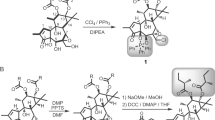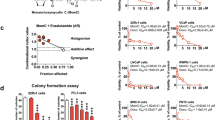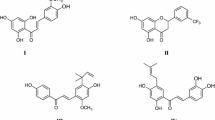Summary
Novel derivatives of K-252a, (8R*,9S*,11S*)-(−)-9-hydroxy-9-methoxycarbonyl-8-methyl-2,3,9,10-tetrahydro-8, 11-epoxy-1H,8H,11H-2,7b,11a-triazadibenzo [a,g]-cycloocta[cde]trinden-1-one, an inhibitor of protein kinases and calmodulin-dependent phosphodiesterase, were synthesized and evaluated for their antitumor activity in vitro and in vivo. Of ten derivatives tested, four were active against the P388 murine leukemia i. p.-i. p. system, although K-252a was inactive. Among these derivatives, KT6124 was selected for further biological evaluation studies because its efficacy was the highest. KT6124 was also active against sarcoma 180 and B16 melanoma. It exerted a relatively broad spectrum of antiproliferative activity against 20 human tumor cell lines in vitro. To determine the mechanism(s) of action underlying the antitumor activity of KT6124, we tested the drug for inhibition of protein kinases, including Ca2+-and phospholipid-dependent protein kinase (PKC), in intact A431 human epidermoid carcinoma cells in comparison with the PKC-inhibitory activity of K-252a. KT6124 did not antagonize the action of phorbol 12-myristate 13-acetate (PMA) in A431 cells, whereas K-252a did, suggesting that KT6124 may not act on protein kinases in the cells. The interaction of KT6124 with DNA in living cells was examined by the alkaline elution method. KT6124 apparantly exhibited DNA scission both dose-and time-dependently in the target cells. The DNA breakage was dependent on proteinase K treatment, suggesting its possible interaction with DNA-related enzyme(s). These results indicate that KT6124 exerts antitumor activity by acting on DNA or on DNA-related enzyme(s) in tumor cells rather than via the inhibition of protein kinases.
Similar content being viewed by others
References
Akinaga S, Gomi K, Morimoto M, Tamaoki T, Okabe M (1991) Antitumor activity of UCN-01, a selective inhibitor of protein kinase C, in murine and human tumor models. Cancer Res 51:4888
Bush JA, Long BH, Catino JJ, Brander WT, Tomoita K (1987) Production and biological activities of rebeccamycin, a novel antitumor agent. J Antibiot 40:668
Geran RI, Greenberg NH, MacDonald MM, Schumacher AM, Abbot BJ (1972) Protocols for screening chemical agents and natural products against animal tumors and other biological activities. Cancer Chemother Rep 3:1
Hirata T, Mochida K, Murakata C, Takahashi M, Kase H, Yamada K, Iwahashi K, Sato A, Kasai M, Kobayashi E, Morimoto M, Akinaga S (1988) Japan Kokai Koho 63-295 589 (CA: 111 (21) 194 456 g) “Preparation of K-252 derivatives as protein kinase C inhibitors and formulations containing them”
Housey GM, Johnson MD, Hsiao HLW, O'Brian CA, Murphy JP, Kriscmeier P, Weinstein IB (1988) Overproduction of protein kinase C causes disordered growth control in rat fibroblasts. Cell 52:343
Hunter T, Ling N, Cooper JA (1984) Protein kinase C phosphorylation of the EGF receptor at a threonine residue close to the cytoplasmic face of the plasma membrane. Nature 311:161
Ido M, Asao T, Sakurai M, Inagaki M, Saito M, Hidaka H (1986) An inhibitor of protein kinase C, 1-(5-isoquinolinylsulfonyl)-2-methyl-piperazine (H7), inhibits TPA-induced reduction of vincristine uptake from P388 murine leukemia cell. Leuk Res 10:1063
Kancko M, Nakayama T, Kodama M, Nagata C (1984) Detection of DNA lesions in cultured human fibroblasts induced by active oxygen species generated from a hydroxylated metabolite of 2-naphthylamine. Jpn J Cancer Res 75:349
Kase H, Iwahashi K, Matsuda Y (1986) K-252a, a potent inhibitor of protein kinase C from microbial origin. J Antibiot 39:1059
Kase H, Iwahashi K, Nakanishi S, Matsuda K, Yamada K, Takahashi M, Murakata C, Sato A, Kaneko M (1987) K-252 compounds, novel and potent inhibitors of protein kinase C and cyclic nucleotide-dependent protein kinases. Biochem Biophys Res Commun 142:436
Matson JA, Claridge C, Bush JA, Titus J, Brander WT, Doyle TW, Horan AC, Patel M (1989) AT2433-A1, AT2433-A2, AT2433-B1 and AT2433-B2, novel antitumor antibiotic compounds produced byActinomadura melliayra. J Antibiot 42:1547
Matsuda Y, Nakanishi S, Nagasawa K, Iwahashi K, Kase H (1988) The effect of K-252a, a potent microbial inibitor of protein kinase, on activated cyclic nucleotide phosphodiesterase. Biochem J 256:75
Meyer T, Regenass U, Fabbro D, Alter E, Rosel J, Muller M, Caravatti G, Matter A (1989) A derivative of staurosporine (CGP 41 251) shows selectivity for protein kinase C inhibition and in vitro anti-proliferative as well as in vivo anti-tumor activity. Int J Cancer 43:851
Morimoto M, Ashizawa T, Ohno H, Azuma M, Kobayashi E, Okabe M, Gomi K, Kono M, Saitoh Y, Kanda Y, Arai H, Sato A, Kasai M, Tsuruo T (1991) Antitumor activity of7-N-{{2-{[2-(λ-l-glutamylamino)ethyl]dithio}ethyl}}-mitomycin C. Cancer Res 51:110
Murakata C, Sato A, Takahashi M, Kobayashi E, Morimoto M, Akinaga S, Hirata T, Mochida K, Kase H, Yamada K, Iwahashi K (1988) US patent 4923 986 (CA: 110 (9) 75861 e) “Preparation of K-252 derivatives as anticancer agents”. United States Patent Office, Washington, D. C.
Nakanishi S, Yamada K, Kase H, Nakamura S, Nonomura Y (1988) K-252a, a novel microbial product, inibits smooth muscle myosin light chain kinase. J Biol Chem 263:6215
Nishizuka Y (1988) The molecular heterogeneity of protein kinase C and its implication for cellular regulation. Nature 334:661
Ohmori K, Ishii H, Manabe H, Satoh H, Tamura T, Kase H (1988) Antiinflammatory and antiallergic effects of a novel metabolite ofNocardiopsis sp. as a potent protein kinase C inhibitor from microbial origin. Arzneimittelforschung 38:809
Persons DA, Wilkinson WO, Bell RM, Finn OJ (1988) Altered growth control and enhanced tumorigenicity of NIH 3T3 fibroblasts transformed with protein kinase C-1 cDNA. Cell 52:447
Ross WE, Glaubiger DL, Kohn KW (1978) Protein-associated DNA breaks in cells treated with Adriamycin or ellipticine. Biochim Biophys Acta 519:23
Takahashi I, Saitoh Y, Yoshida M, Sano H, Nakano H, Morimoto M, Tamaoki T (1989) UCN-01 and UCN-02, new selective inhibitors of protein kinase C: II. Purification, physico-chemical properties, structural elucidations and biological activities. J Antibiot 42:571
Tamaoki T, Nakano H (1990) Potent and specific inhibitors of protein kinase C of microbial origin. Biotechnology 8:732
Tamcoki T, Nomoto H, Takahashi I, Kato Y, Morimoto M, Tomita F (1986) Staurosporine, a potent inhibitor of phopholipid/Ca2+-dependent protein kinase. Biochem Biophys Res Commun 135:397
Author information
Authors and Affiliations
Rights and permissions
About this article
Cite this article
Akinaga, S., Ashizawa, T., Gomi, K. et al. Antitumor effect of KT6124, a novel derivative of protein kinase inhibitor K-252a and its mechanism of action. Cancer Chemother. Pharmacol. 29, 266–272 (1992). https://doi.org/10.1007/BF00685943
Received:
Accepted:
Issue Date:
DOI: https://doi.org/10.1007/BF00685943




